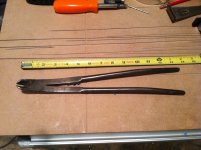ear3
Member
I'm repurposing some of the offcuts from my maple slab, and with one of them, while I was putting in it a 1 1/4" Spax screw, I forgot to engage the torque setting on my T18 and snapped the head off, leaving the entire length of the screw embedded and inaccessible in the wood.
It's not a disaster from a visual standpoint, as the screw was not going to be visible, but I've since decided that I wanted to do something else with the piece that would involve passing a router directly over where the screw is stuck. I've had to remove screws before whose heads were stripped, but never the decapitated shaft of an embedded screw. I'm not worried about leaving a gaping hole in the piece (it won't be visible), just as long as it's only on one side -- so is the best method just to bore out the screw with a larger diameter drill bit? Any other solutions that don't involve sacrificing a drill bit?
It's not a disaster from a visual standpoint, as the screw was not going to be visible, but I've since decided that I wanted to do something else with the piece that would involve passing a router directly over where the screw is stuck. I've had to remove screws before whose heads were stripped, but never the decapitated shaft of an embedded screw. I'm not worried about leaving a gaping hole in the piece (it won't be visible), just as long as it's only on one side -- so is the best method just to bore out the screw with a larger diameter drill bit? Any other solutions that don't involve sacrificing a drill bit?



